Desmond Kuah's essay, originally added in November 2000 as a useful introduction to the events of 1857, has been revised and considerably expanded to take account of a variety of writings on the subject, both in India and Britain, and the Victorian Web's own greatly enlarged cache of materials in this area. Click on the images for larger pictures, and for more information about them where available. — JB
Introduction
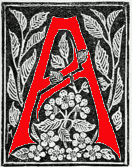
t the beginning of the nineteenth century, despite having lost her American colonies in the previous century, Britain was still the world's greatest Imperial power, her position "emphatically confirmed by her victory in the Napoleonic wars" (Cain 31). This growing influence reinforced the belief that the British themselves were the chosen race — chosen to bring the benefits of western civilization to the backward areas of the world. Such an attitude of racial supremacy increasingly determined Britain's dealings with her remaining colonies, especially India, and naturally provoked native opposition. But most resistance, even that attendant on her conquest of Sindh in 1843 and the Punjab in 1849 (after the two Anglo-Sikh wars), proved unsuccessful due to the superior technology and organization of the British army.
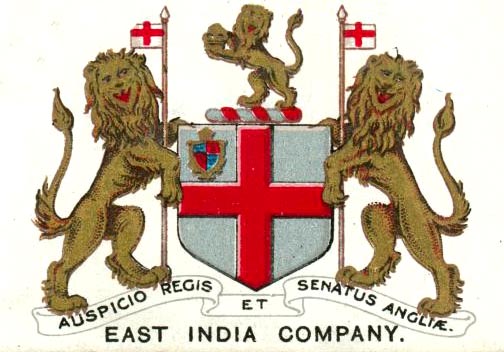
However, in India in 1857, the British colonial administration, at that time under the aegis of the East India Company (often abbreviated to EIC), faced its biggest challenge yet. As William Dalrymple points out, it is misleading to see what happened there at this time either as a "single coherent mutiny," or, on the other hand, as a single "patriotic national war of independence." Dalrymple continues, "there was in reality a chain of very different uprisings and acts of resistance, whose form and fate were determined by local and regional situations, passions and grievances" (16). Thanks to the efficiency of British media coverage, the development of these events was followed avidly by the British public at home. It saw the army's stand as a fight against barbarians who were rejecting the benefits of civilization; but, as the suppression developed, the atrocities committed by both sides became obvious. The British armies swept across northern India in an enraged and cruel rampage which shocked Victorian society. The unfolding narrative was termed the "epic of the Race" by Sir Charles Crosthwaite (see Nayar 20; Morris 502, n.1), Lieutenant-Governor of the North-West Frontier; and although this may sound exaggerated in the modern context, it was certainly epoch-making, and also a telling reflection on Victorian British self-confidence and the extent to which it was shaken at this time.
The Background, 1857

A Company's Sepoy, 1815, one of a suite of 11 original unsigned watercolours, evidently by a native artist.
British presence in India stretched all the way from the seventeenth century when the EIC acquired its first territory in Bombay, to 1947 and Partition, when India and Pakistan were granted self-rule. Over the years the EIC expanded by both direct (force) and indirect (economic) means, eventually chasing the French out after the War of Plassey (1757) and dominating the whole of the Indian sub-continent. British rule in India rested on its military might and as long as the British army in India was invincible, British rule was assured. This of course depended on the Indian army, which consisted of Indian troops under British officers.
British rule inevitable brought western influences into India. The spread of Christianity was to cause great unease among the Indians. Even such well-known Evangelical Christian missionaries as Bishop Heber had little understanding and respect for India's ancient faiths: Dalrymple quotes Heber's "From Greenland's Icy Mountains," with its reference to the indigenous people as "vile," and to the "heathen in his blindness," as an example of their attitudes (63), and their efforts to convert many natives brought clashes with the local religious establishments. As the missionaries were generally British citizens, the Colonial administration often had to intervene to protect them, which naturally gave an impression of official support for Christianity.
Against this backdrop of uneasiness the mutiny erupted in 1857. As is well known, the spark was not so much direct religious clashes, but the grease used in the new Enfield rifle. The cylindrical cardboard cartridge used for the gunpowder and bullet in the rifle was heavily greased with animal fat, to facilitate loading it into the muzzle. Rumors began to circulate among the sepoys that the grease was a mixture of cow (sacred to Hindus) and pig (abhorrent to Muslims) fat. Biting such a cartridge open in order to prepare it for firing would break the caste of the Hindu sepoys and defile the Muslims. Their British officers realized their mistake and changed the grease to beeswax or vegetable oils, but in the atmosphere of distrust, amid "fears that the British were bent on destroying a familiar way of life" (Mukherjee and Kapoor 13), the mutiny seemed inevitable.
Meerut
Although a disaffected sepoy named Mangal Pandey, and a native lieutenant on duty on the day of Pandey's attack on his regimental adjutant, were hanged at Barrackpore (see Featherstone 106), Meerut witnessed the first serious outbreak of rebellion when angry sepoys broke open the town jail and released their comrades, who had refused to bite the new cartridges. Accompanied by a mob from the bazaar, the mutineers then poured into the European settlement and slaughtered any Europeans or Indian Christians there. Whole families, men, women, children and servants, were killed on sight. The cantonment was then burned, and the mutineers fled to Delhi and, hoping to create a general uprising against the British, proclaimed Bahadur Shah Zafar II, the last of the Mughal dynasty, their leader. A highly cultured figure who was already little more than a figurehead, Zafar felt he had no option but to cooperate, and accepted the allegiance of the mutineers. During the sepoys' occupation of Delhi, most of the Europeans living in Delhi were murdered, again, as P. J. O. Taylor says, "regardless of sex or age or occupation" (17), along with Indian converts to Christianity. Under the shock of this indiscriminate assault, it is fair to say that the inherently uneasy mixture of values on the British side too, derived from the Utilitarian as well as Evangelical thinking of the period, "underwent a shocking disintegration" (Herbert 30).

The 9th-Queen's-Royal Lancers attacking mutineers in India, by Orlando Norie (1832-1901), a watercolour of 1858.
The massacres at Meerut and Delhi provoked a strong British response. In mid-August, British forces, reinforced by Gurkhas from Nepal and the Queen's regiments fresh from the Crimean War, began a bloody campaign to re-establish British rule in India. After a prolonged siege full of deprivations on both sides, Delhi fell to the British. Along with the mutineers, three of the Emperor's sons, Mirzas Mughal, Khizr Sultan and Abu Bakr, who had commanded the insurgents, were executed: the princes were taken and shot personally, at point blank range, by Major Hodson of Hodson's horse, to whom their father had previously surrendered (see Dalrymple 306; Hodson's own father was an Evangelical Archdeacon, and the Major's tomb, with carvings of his exploits, including the surrender of the old Emperor, is to be seen opposite his father's at Lichfield Cathedral). The octogenarian Emperor and those of his immediate family who remained with him would eventually be exiled to Burma.
The Aftermath


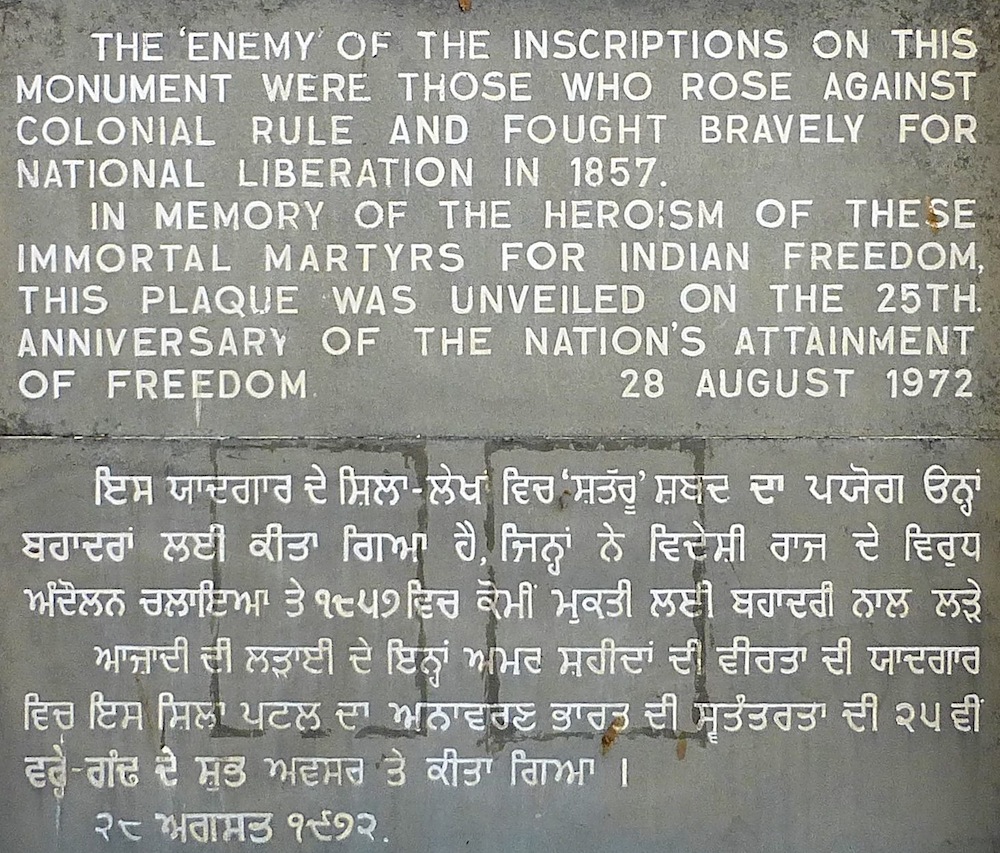
Two diametrically opposed points of view. From left to right: (a) The Mutiny Memorial, Delhi, erected on the Ridge, from where the British laid siege to, and eventually stormed, the city. (b) The original inscription, reading "In Memory of those officers and soldiers, British and Native, of the Delhi Field Force who were killed in action or died of wounds or disease between 30th May and 20th September 1857." (c) Plaque added in 1972 t0 commemorate those "who rose against colonial rule and fought bravely for national liberation in 1857" as "immortal martyrs for Indian freedom." Photographs © Medha Malik Kudaisya (left), and JB (middle and right).
By the first six months of 1858, then, the British had managed to regain their losses in spite of heavy resistance from the rebels. With the relief of Lucknow (where Major Hodson lost his life), the possibility of British defeat became remote. The army could focus on retribution. The British are widely said to have seen themselves as dispensers of divine justice, and, given the initial atrocities committed by the mutineers, to have viewed their cruelties as simply repayment in kind:
As myths of the mutiny grew, every dead British child became a slaughtered angel, every woman a violated innocent, every sepoy a black-faced, blood-crazed savage. There was little room for mercy in the hearts of the British troops and those, such as Governor Lord Canning, who spoke of restraint were derided by their countrymen. Canning became known contemptuously as "clemency Canning." [Mehta 93-94]
The fact that Charles Canning was shown in the Punch of 24 October 1857 with a fatherly hand on a diminutive sepoy's head supports such a viewpoint. However, as Christopher Herbert has argued so convincingly, the British response was far from "monolithic" or "self-consistent" (5). Canning, for instance, also earned the name of "Canning the Just," and later, as the first Viceroy, would do much to redeem the British record in India, especially in the fields of education and administration (see Metcalf). It should be noted too that Disraeli himself protested strongly against "meeting atrocities with atrocities" (qtd. in Dalrymple 456), as did the MP for Bradford, General Thomas Perronet Thompson, who, speaking in a parliamentary debate on India in February 1858, categorically blamed the entire crisis "on the arrogance and racism of the British in India, particularly on the religious establishment, and on the sadistically cruel harshness of the punitive policies adopted by the British government" (Herbert 158). But it would be some time before British fury abated.
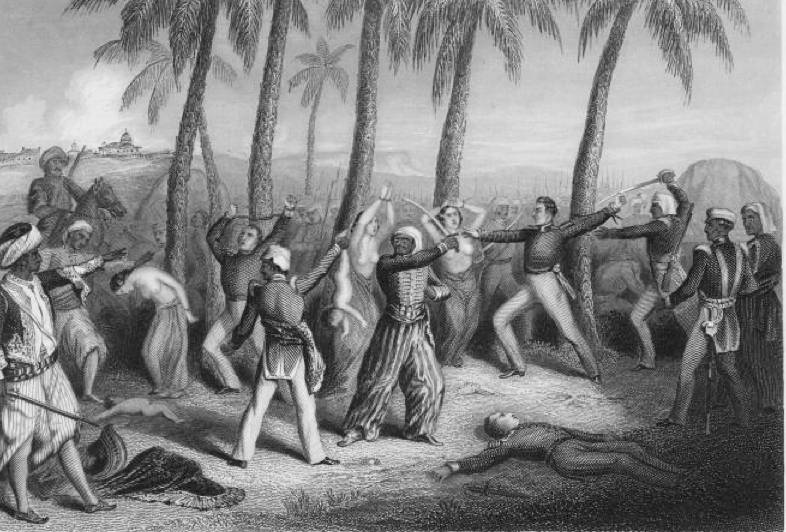
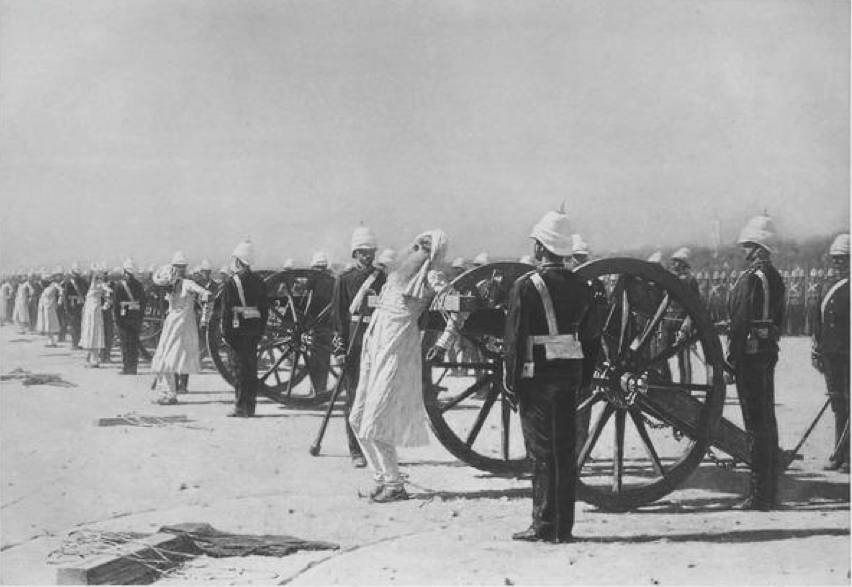
Atrocities on both sides shown in two Library of Congress images. Left: Massacre of English officers and their Wives at Jhansi, showing the victim on the right in the pose of crucifixion. Right: Another Library of Congress image shows a grey-bearded Indian man (the one to the right) affixed with outstretched arms, about to be blown from the cannon, and looking very much as if his imminent punishment too is a form of crucifixion.
After the British recovered control, few sepoys survived as those who remained were bayoneted or otherwise slaughtered. Indeed, whole villages were wiped out, their inhabitants hanged for some real or imagined sympathy for the mutineers, and the widespread looting of Indian property, religious or secular, was common and endorsed. Later, convicted mutineers were lashed to the muzzles of cannon and had a roundshot fired through their body. Not unnaturally, like suttee, this unbelievably brutal punishment has attracted special attention in recent years. Though generally instantaneous enough, it had a further dimension: by dispersing the body into atoms, it could be assumed to deprive the victim of any hope of an afterlife. Presented in an article in Household Words as "one of the institutions of Hindustan" which older people might remember having heard about in their youth (Craig 348) — in other words, a procedure revived rather than invented — it seems to have been considered an appropriate retribution for what both sides saw as "the devil's wind" of rebellion, that had spread from Meerut like the hot dry wind of the sub-continent itself ("When the Sepoys who were taken at Cawnpore were asked why they had mutinied, they replied: "Surely it was a madness — a wind from the Devil was abroad in Hindostan," Wentworth, title page). The commentator who wrote about this type of execution in horrifyingly graphic detail in Household Words persuaded himself that the Indians were inured to it. Nevertheless, he concluded that: "As soon ... as the present crisis has passed, when the mutiny shall be over, I for one would recommend the abolition of this punishment" (Craig 350). Note that the image above right not only seems purposely to focus on an old man, well beyond fighting age, but shows the cross-like contraption used for fixing victims to the cannon in the foreground, subtly reinforcing the idea of a crucifixion. When looking at a Punch cartoon on the subject, Herbert too finds evidence of "conscience ... peeking out despite all attempts to repress it" (46).

John Tenniel's cartoon in the Punch of 15 April 1976, after the successful passing of the Royal Titles Bill made her Empress of India.
Apart from the even now deeply troubling fury of the British, another significant impact for India was the winding up of the EIC. The British Parliament finally realized that it was inappropriate for a private company to exercise such enormous powers and control a land the size of India. Despite a valiant defense of its purported achievements by John Stuart Mill, who saw it as having "preserved Indian administration from the whirlpool of British politics" (Spear 148), it was dissolved in 1858, and the administration of India became the responsibility of the Crown. Direct rule on India was exercised through the India Office, a British department of state, which was moved from its old premises to a grand new building adjoining the Foreign Office, complete with splendid Durbar Court for receptions and other ceremonial occasions. Until India finally achieved Independence in 1947, again at great cost, British rule in India became known as the Raj, the Crown Jewel of Queen Victoria's extensive empire. An epic story indeed, and one that does Britain no credit, but would at least leave it struggling, in Herbert's words, "to salvage its belief in its own humanitarian idealism" (287). We have to ask ourselves whether it managed to do so, and indeed whether the West is doing any better in its international relationships now.
Related Material
- The Company's Raj
- Timeline of British India
- The 1857 Indian Mutiny (also known as the Sepoy Rebellion, the Great Mutiny, and the Revolt of 1857)
- Representations of the Indian Mutiny in Victorian Higher Journalism
- Articles about the Indian Mutiny in Victorian Periodicals
- Punch on the 1857 Indian Mutiny
Bibliography
Cain, P. J. "Economics and Empire: The Metropolitan Context." Porter 31-52.
Craig, George. "Blown Away!" Household Words, Vol. 17. 27 March 1858. 348-50. Internet Archive. Contributed by the University of Buckingham. Web. 17 February 2015.
Dalrymple, William. The Last Mughal: The Fall of a Dynasty, Delhi, 1857. Delhi: Penguin, 2007.
Featherstone, Donald. Victorian Colonial Warfare: India. London: Cassell, 1992.
Herbert, Christopher. War of No Pity: The Indian Mutiny and Victorian Trauma. Princeton and Oxford: Princeton University Press, 2008.
Mehta, Arun C. History of Modern India. Jaipur: ABD, 2004.
Metcalf, Thomas R. "Canning, Charles John, Earl Canning (1812–1862), governor-general and first viceroy of India." Oxford Dictionary of National Biography. Online ed. Web. 17 February 2015.
Morris, Jan. Pax Britannica: The Climax of an Empire. London: Faber, 1998 (now available as an e-book).
Mukherjee, Rudrangshu, and Pramod Kapoor. Dateline 1857: Revolt against the Raj. New Delhi: Lustre Press, Roli Books, 2008.
Nayar, Pramod K. The Penguin 1857 Reader. New Delhi: Penguin, 2007.
Porter, Andrew, ed. The Oxford History of the British Empire. Vol. III: The Nineteenth Century. Oxford: Oxford University Press, 1999.
Spear, Percival. A History of India: Vol. II: From the Sixteenth Century to the Twentieth Century. New Delhi: Penguin Books India, 1990.
Taylor, P. J. O. A Star Shall Fall. New Delhi: Indus, 1993.
Washbrook, D. A. "India, 1818-1860." Porter 395-421.
Wentworth, Patricia. The Devil's Wind. New York: Putnam's Sons, 1912. Internet Archive. Contributed by the Harold B. Lee Library of Brigham Young University. Web. 17 February 2015.
Last modified 17 February 2015